
Through 10 films, several TV series, and dozens of music videos, David Fincher has spent his professional career as a film director honing his craft and perfecting his unique sense of storytelling. His use of dramatic characterization, stark imagery, and pulse-pounding suspense have put him at the forefront of Gen-X directors who encapsulate what it means to “do-it-yourself.”
Beginning with his much-maligned directorial debut, Alien 3 (1992), Fincher established himself as an uncompromising auteur for big-budget projects and firmly stood his ground for creative control, even against the best efforts of the Hollywood machine. His first film would be a major critical and commercial failure and a personal sore-spot in an otherwise exemplary filmography, but the lessons Fincher learned from that heartache have continued to stay with him and guide him in wholly inspirational ways.
In an impossible effort to distill this inspiration down to its roots, 10 scenes have been chosen from Fincher’s impressive body of work as a benchmark for the director’s singular approach to visual storytelling. Certain scenes exemplify how the use of distinct camera movements and angles can emphasize a particular tone or emotion in the film, while others establish a synthesis of various elements which have been presented throughout the film and effectively symbolize an overall theme.
1. Film: Se7en (1995), The Library
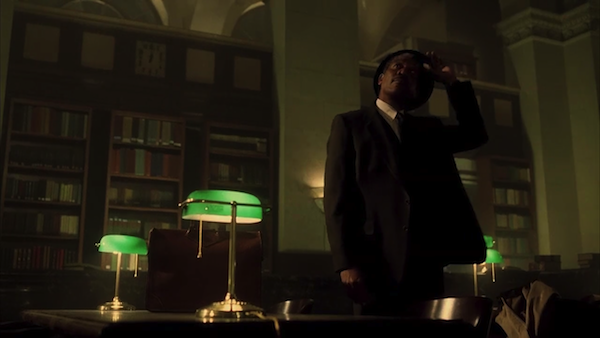
Scene: With his first film since the Alien 3 debacle, Fincher set his sights on the seedy underbelly of an unnamed city and on the dreary souls unfortunate enough to live there, and in the process created a bonafide genre classic that would cement his name in every filmgoer’s mind forever. Se7en follows veteran Detective Somerset and rookie Detective Mills on the hunt of a crazed serial killer named John Doe, who is exacting his own brutal form of justice based on the seven deadly sins: gluttony, greed, sloth, envy, wrath, pride, and lust.
Early on in the film, Somerset is seen visiting a library in which he clearly feels at home and proceeds to scour through shelves of books in search of anything related to the seven deadly sins case. While he looks around, a group of security guards busy playing cards put on a rendition of Johann Sebastian Bach’s “Air on the G String” over their radio and create a rather fitting diegetic soundtrack for the detective.
The music accompanies Somerset for the entire scene and seems to pick up and become even bolder while the detective reads through copies of Dante’s Purgatory, The Canterbury Tales, and Paradise Lost. Intercut throughout this scene are quick snippets of Detective Mills as he reads the case files for John Doe’s latest killing.
Significance: This is a particularly vital scene in the film not only for how well it examines both detectives’ professional approaches to solving a homicide case, but also for the ways in which these heinous crimes begin to manifest themselves in the lives of two men with vastly different personal experiences. By this point, it has already been established that Somerset is working his last week before retirement and that Mills is a young cop who is new to the city and is to be Somerset’s replacement.
Here, Somerset represents the “old-school” method of investigating while Mills represents the new, and regrettably naïve, approach to police work. Each detective carries the weight of what they’ve seen and done differently, resulting in a symbolically fractured partnership with either side unsure of what the other is capable of understanding or appreciating.
Fincher is able to capture these two different attitudes by implementing various crosscuts between the two main characters, a technique used especially well in some of the director’s later work. This is also true for the music as well, which is important to note because it presents a certain dissonance between the tranquility of the library with the Bach melody and its juxtaposition against the grisly images that Mills must comb through for clues. This dissonance ultimately becomes one of the most poignant themes in the film once it reaches its devastating conclusion.
2. Film: Se7en (1995), The Chase
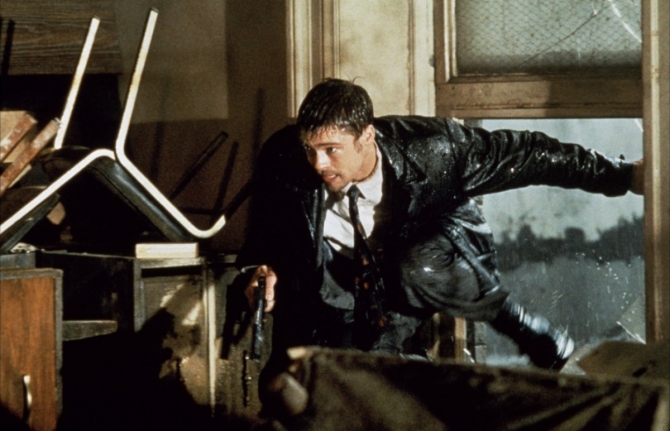
Scene: In what is sure to be remembered as one of the greatest foot-pursuits in cinematic history, Detectives Somerset and Mills track an ill-gotten lead which takes them to the apartment of a possible suspect known only as John Doe. Upon arriving at the apartment, a figure shrouded in shadows and a trench coat immediately opens fire on the detectives. Having missed his intended targets, the figure turns back and runs down the apartment building stairs. Mills follows closely while Somerset attempts to circumnavigate the labyrinth of apartments and cut the suspect off.
After chasing this figure through numerous halls, stairwells, and apartments, (all while getting shot at), Mills follows him out onto a rooftop and down a fire escape to the rain-slicked streets below.
Through a narrow alleyway, Mills thinks he has the suspect cornered and slowly makes his way alongside a parked truck. From above, Mills is clobbered in the head with a tire iron and drops his gun. The figure appears beside him and shoves a gun in his face, just waiting and watching. For a moment it seems like Mills is doomed, but Somerset is heard just around the corner and manages to find his partner on the ground, wounded but very much alive. The figure has vanished.
Significance: This scene represents a dramatic turning point for the two main characters, Somerset and Mills, and shows that these detectives are not only willing to do any means necessary in the pursuit of their suspect, but also that their suspect is not merely another “perp” who the police can afford to underestimate.
Somerset’s crafty plan to use library records as a way of tracking potential suspects serves as yet another delineation between himself and Mills’ strong headedness, which as it is shown here, clearly gets him into far greater danger than it does getting him closer to the truth. John Doe is now aware that the police are gaining on his tail, but he also now knows exactly who in the police is after him and who he can use to continue his killing spree.
Fincher’s direction is undeniably superb throughout this scene, as he is able to evoke feelings of both dread and claustrophobia by effectively weaving around all of the action and making every second count.
By the time Mills and John Doe are outside on the roof, Fincher has already achieved a small victory by forcing the audience to distrust typical detective film conventions and to contemplate the possibility of Mills’ failure, either by letting John Doe escape or by an unfortunate mistake which could get him killed. In the end, it is a bit of both, but John Doe’s ultimate decision to leave Mills alive has less to do with making his escape easier and more with saving the detective for an even worse fate to come.
3. Film: The Game (1997), Opening Sequence
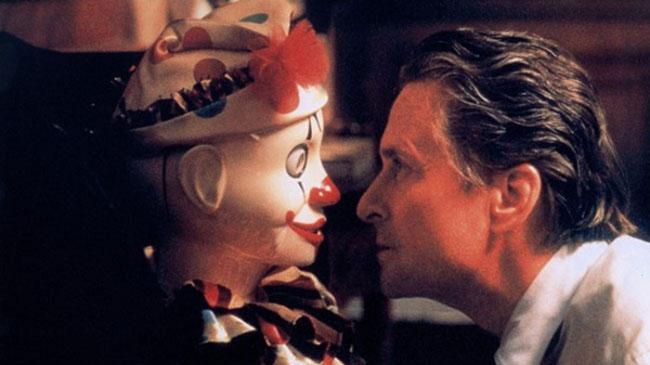
Scene: The Game is one of David Fincher’s most underrated films and a true gem of the psychological thriller genre, acting as a study into the themes of anguish, alienation, apathy, and inevitable acceptance. Nicholas Van Orten is a wealthy businessman living a life of self-imposed loneliness when his estranged brother gives him an invitation to a mysterious role-playing game for his birthday.
In the film’s opening sequence, a 16mm home-movie montage depicts the last day in the life of Nicholas’ father on his 48th birthday. Nicholas is a just child and is shown running around his family’s mammoth estate, playing games with friends, and lastly taking a somber picture with his father.
Other images edited into this montage include various family members and friends, an uneasy (and foreboding) group of circus clowns, and most importantly, numerous shots of Nicholas’ father as he mechanically moves around the party and flashes mirthless grins at the camera. His obvious depression is palpable and is eerily mirrored in his son’s face when the two are shown together.
Though we don’t know it yet, this will be his father’s last moments before leaping to his death from the roof of their mansion, an act which will remain with Nicholas up to his own 48th birthday and the beginning of the film.
Significance: By depicting the exact day in which Nicholas’ life changed as an apparently happy one marred by a tragic, though arguably foreseeable event, Fincher has yet again created a level of dissonance that threads throughout the entire film. The choice to use a weathered 16mm look for the opening sequence gives the audience an immediate feeling of familial nostalgia and makes the images of Nicholas with his father all the more resonant.
Similarly, Fincher’s choice to withhold the image of Nicholas’ father leaping to his death until it appears as a brief memory later on in the film exemplifies a principal theme of isolation.
Another aspect of this opening sequence that is especially noteworthy is the inclusion of certain visuals which will eventually act as conduits for Nicholas’ painful memories once the titular “game” begins.
These visuals include a children’s puppet show, the circus clowns, and the image of someone being pushed into a pool of water. Fincher utilizes every single element here in an effort to create a lasting impression on the audience and to force us into experiencing the same emotional torment that will continue to haunt Nicholas until he is finally able to reach some sort of acceptance.
4. Film: Fight Club (1999), Lou’s Tavern and Tyler’s “Rules”
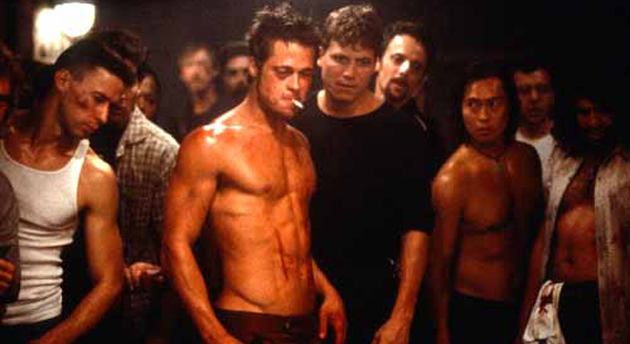
Scene: Fight Club may very well be David Fincher’s best known work, and the film that catapulted his career to the heights it continues to build from now, but much of the film uses surprisingly simple narrative and framing devices which help make the whole experience relatively easy-going and certainly entertaining.
The story of an insomniac searching for something or someone to take away his indescribable pain of monotony, Fight Club builds on a dichotomy of self-fulfillment and self-destruction. This contradiction takes the form of Tyler Durden and his seemingly straightforward idea to start an actual fight club in order to “finally feel something real.”
Once fight club becomes too big for its late-night parking lot origins, though, a new venue is found in Lou’s Tavern. Using a characteristically impressive tracking shot, the camera follows Tyler and the sleepless Narrator through Lou’s and down to the cellar below, which will now serve as the fight club’s new battlegrounds. Here is where Tyler begins to lay out his new vision for fight club and presents all of its members with a list of “rules” which must never be broken (even by him). If the first rule of fight club is, “You do not talk about fight club,” then the second rule of fight club is even clearer in its intention.
Significance: The tracking shot in this scene is especially noteworthy, due in part, for the fact that we as the audience can now feel embedded within the fight club as we move through the doors of Lou’s Tavern with Tyler and the Narrator, gliding along the bar and then down to the cellar. Fincher is able to capture the rushing narrative of Chuck Palahniuk’s novel by placing us within the story and giving us the opportunity to explore this secretive world of self-destruction.
As the Narrator experiences this world for the first time, we also experience the same fear and adulation that others have decidedly thrust upon Tyler as a group figurehead, and upon the nature of fight club as an outwardly fulfilling way of life.
5. Film: Fight Club (1999), Finale
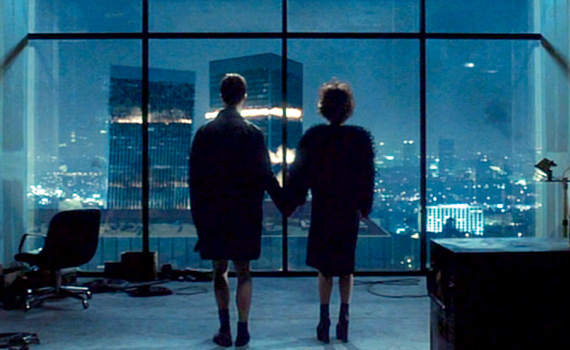
Scene: In Fight Club’s undeniably brilliant finale, the Narrator has finally broken free of Tyler’s control and manages to put Tyler out the back of his mind, literally, but the damage is already done. Tyler’s master plan is going to be carried out flawlessly and all the Narrator can do now is watch.
Standing beside one another and holding hands as they stare out of the window, the Narrator and Marla watch in a trance as the headquarters of every major credit card company begins to implode within. Tyler’s wish has come true. The Narrator just turns to Marla and fittingly admits that she “met him at a very strange time in his life.”
Significance: Fincher shows that, although Tyler has been physically removed from the Narrator’s fractured psyche, his plan to sabotage an idolized pillar of corporate America is nonetheless successful; that the Narrator’s efforts to stop Tyler are ultimately useless, but that this hopeless endeavor also brings him back to Marla.
This symbolic imagery is yet another example of the dichotomy between self-fulfillment and self-destruction that is present throughout the film and which the finale heavily capitalizes on. The destructive nature of Tyler Durden is defeated and the Narrator becomes free to find that which will give his life fulfillment: Marla. In this sense, Fight Club is Fincher’s first (and possibly only) foray into capturing the complexities and sheer madness of true love.